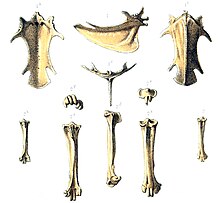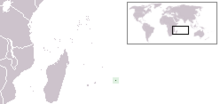Rodrigues grey pigeon
| Rodrigues pigeon | |
|---|---|
 |
|
| Subfossil bones, 1866 | |
| Scientific classification | |
| Kingdom: | Animalia |
| Phylum: | Chordata |
| Class: | Aves |
| Order: | Columbiformes |
| Family: | Columbidae |
| Genus: | Nesoenas |
| Species: | †N. rodericanus |
| Binomial name | |
|
Nesoenas rodericanus (Milne-Edwards, 1873) |
|
 |
|
| Location of Rodrigues | |
| Synonyms | |
|
Columba rodericana Milne-Edwards, 1873 |
|
Columba rodericana Milne-Edwards, 1873
Streptopelia rodericana
Ptilinopus rodericana
Nesoenas picturatus rodericanus
Alectroenas rodericana Rothschild, 1907
The Rodrigues pigeon, also known as Rodrigues dove (Nesoenas rodericanus) is an extinct species of pigeon formerly endemic to the Mascarene island of Rodrigues. It is known from a subfossil sternum and some other bones, and the descriptions of Leguat (1708) and Julien Tafforet (1726).
This bird was assigned to the genus Alectroenas, but this was erroneous. It is most similar to that of the ground doves (Gallicolumba) or to a miniature version of the sternum of an imperial pigeon (Ducula). If this similarity is not based on convergence, considering the evolutionary relationships of the dodo and the Rodrigues solitaire, the Rodrigues grey pigeon is quite possibly the closest relative of the Raphidae that was still alive in historic times. This does not mean that there is any close relationship between this bird and the didine pigeons, only that both derived, independently, from the same Indo-Asiatic lineage, which became extinct millions of years ago.
Two tarsometatarsi were attributed to this species. Today, they are believed to represent another taxon, closer to the Madagascar turtle dove (Nesoenas picturata), and thus the name Rodrigues turtle dove also refers to the present species.
...
Wikipedia

